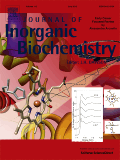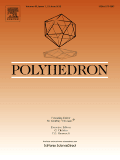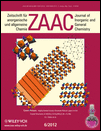
JOURNAL OF BIOLOGICAL INORGANIC CHEMISTRY
Scope & Guideline
Illuminating the Role of Metals in Biological Processes.
Introduction
Aims and Scopes
- Bioinorganic Chemistry:
The journal primarily addresses the role of metal ions in biological systems, including their biochemical functions, mechanisms of action, and the synthesis of metal-based compounds that influence biological activity. - Medicinal Applications of Metal Complexes:
There is a consistent focus on the development of metal complexes as therapeutic agents, including anticancer, antimicrobial, and antiviral properties, highlighting the potential of these compounds in medical applications. - Metal-Protein Interactions:
Research on the interactions between metal ions and proteins, including the role of metal ions in enzyme catalysis, metalloproteins, and the structural and functional implications of these interactions. - Analytical Techniques in Bioinorganic Chemistry:
The journal emphasizes the use of advanced analytical techniques such as spectroscopy, electrochemistry, and computational methods to elucidate the behavior of metal ions in biological systems. - Environmental and Ecotoxicological Studies:
Research that explores the impact of metal ions in the environment, including their biological effects and potential toxicological implications, is also an important area of focus.
Trending and Emerging
- Nanotechnology in Medicine:
There is a significant increase in research involving nanostructured materials and nanotechnology applications for drug delivery, imaging, and therapeutic agents, particularly in cancer treatment and antimicrobial resistance. - Metalloenzymes and Biocatalysis:
An expanding focus on the study of metalloenzymes, their mechanisms, and their potential applications in biocatalysis signifies a growing interest in harnessing nature's catalysts for industrial and therapeutic purposes. - Metal-based Therapeutics:
The development of novel metal-based therapeutics, including targeted drug delivery systems and multifunctional agents, is gaining momentum, with increasing evidence supporting their efficacy in treating various diseases. - Selenium and Other Bioactive Metals:
Emerging research on the role of selenium and other trace metals in health and disease, particularly their antioxidant properties and potential therapeutic uses, is on the rise, reflecting a broader interest in bioactive metals. - Environmental Biochemistry of Metals:
Research exploring the biochemical interactions of metals in environmental contexts, including their roles in microbial systems and bioremediation strategies, is increasingly relevant and gaining traction.
Declining or Waning
- Traditional Coordination Chemistry:
There appears to be a waning interest in classical coordination chemistry studies that do not directly relate to biological systems. Research that focuses purely on coordination complexes without biological context is less frequently published. - Inorganic Materials Science:
The journal has seen a reduction in submissions related to inorganic materials science that do not have a clear biological application or relevance, indicating a shift towards more biologically focused studies. - Basic Metal Chemistry:
Research focused on the fundamental aspects of metal chemistry, such as simple synthesis and characterization without biological implications, is becoming less prominent as the field increasingly emphasizes bioactivity and applications.
Similar Journals

Organics
Exploring the Depths of Organic Chemistry KnowledgeOrganics is a peer-reviewed journal dedicated to the advancement of research in the field of organic chemistry, published by MDPI, a renowned leader in open access publication. Since its inception in 2020, the journal has embraced an open access model, ensuring that cutting-edge research is freely available to researchers, professionals, and students worldwide. With a current impact factor reflecting its relevance in the community, Organics aims to provide a platform for high-quality research, reviews, and insights that foster innovation and collaboration in the organic chemistry domain. The journal's scope encompasses a broad range of topics within organic chemistry, making it an essential resource for those involved in various research endeavors. As it converges from 2020 to 2024, Organics is set to build on its solid foundation and enhance its scholarly contributions by attracting significant research contributions that align with the latest scientific developments. Based in Basel, Switzerland, the journal's commitment to quality and accessibility resonates strongly with today's research landscape, making it a pivotal asset for anyone invested in the future of organic chemistry.

Journal of Spectroscopy
Pioneering Research in the World of SpectroscopyJournal of Spectroscopy, published by HINDAWI LTD since 2009, is a renowned Open Access journal based in Egypt that serves as a valuable platform for the dissemination of cutting-edge research in the fields of analytical chemistry, atomic and molecular physics, and optics. With the unique ISSN 2314-4920 and E-ISSN 2314-4939, this journal aims to facilitate collaboration and knowledge exchange among researchers, professionals, and students by providing unrestricted access to essential findings and advancements. As of 2023, it holds a Q3 ranking in both Analytical Chemistry and Atomic and Molecular Physics, and a Q4 ranking in Spectroscopy, indicating its growing influence and relevance within the academic community. The journal also maintains a Scopus rank of #126 in Atomic and Molecular Physics and #53 in Spectroscopy, showcasing its commitment to high-quality scholarly content. With a converged timeline from 2013 to 2024, the Journal of Spectroscopy is positioned as a pivotal resource for the latest discoveries and innovative applications in spectroscopy-related studies.

JOURNAL OF INORGANIC BIOCHEMISTRY
Fostering Innovation in Inorganic Biochemistry ResearchJOURNAL OF INORGANIC BIOCHEMISTRY, published by Elsevier Science Inc, is a pivotal journal dedicated to exploring the intricate intersections of biochemistry and inorganic chemistry. With an ISSN of 0162-0134 and an E-ISSN of 1873-3344, this esteemed journal has been a key resource since its inception in 1979, converging its insights through impactful research projections until 2024. Currently ranked #18 out of 79 in Inorganic Chemistry, placing it in the 77th percentile, and #144 out of 438 in Biochemistry, at the 67th percentile, the journal showcases a diverse array of studies that contribute significantly to understanding the roles of inorganic compounds in biological systems. Although it does not offer open access, the journal remains integral in fostering rigorous academic discourse among researchers and professionals keen on advancing the field. With a Category Quartile ranking of Q3 in Biochemistry and Q2 in Inorganic Chemistry, it serves as a critical platform for scholars aiming to disseminate cutting-edge findings and stimulate scholarly engagement in this dynamic area of study.

RUSSIAN JOURNAL OF COORDINATION CHEMISTRY
Pioneering Research in Metal-Organic RelationshipsThe Russian Journal of Coordination Chemistry, published by Pleiades Publishing Inc, stands as a significant contribution to the field of coordination chemistry, focusing on the intricate relationships between metal ions and organic molecules. With an ISSN of 1070-3284 and an E-ISSN of 1608-3318, this journal has been curating high-quality research since its inception in 1996. Though it currently does not offer open access, the journal plays a crucial role in disseminating innovative findings, evidenced by its Q3 ranking in both Chemical Engineering and Chemistry categories as of 2023. With Scopus rankings placing it in the 40th percentile among general chemistry and chemical engineering journals, it demonstrates a commitment to advancing knowledge in these vital areas. The journal invites researchers, professionals, and students alike to engage with its comprehensive articles that explore both theoretical and practical aspects of coordination chemistry, supporting the development of new applications and techniques within the field.

INORGANICA CHIMICA ACTA
Elevating Knowledge in Physical and Theoretical ChemistryINORGANICA CHIMICA ACTA is a distinguished journal published by Elsevier Science SA, focusing on the dynamic fields of inorganic chemistry, materials chemistry, and physical and theoretical chemistry. Established in 1967, the journal continues to contribute to the scientific community with a commitment to high-quality research and innovation, boasting a 2023 Scopus ranking that places it at the forefront of its category, including a notable rank of #25 out of 79 in Inorganic Chemistry. Researchers can access a wealth of knowledge through its assemblage of influential articles; though it does not offer open access, the journal remains a key resource in the Netherlands and beyond. With an impact factor reflective of its rigorous editorial standards and engagement, INORGANICA CHIMICA ACTA is essential for scholars and professionals seeking to deepen their understanding and advance their research in these interconnected scientific domains.

RUSSIAN JOURNAL OF INORGANIC CHEMISTRY
Exploring the Depths of Inorganic ChemistryThe Russian Journal of Inorganic Chemistry is a distinguished publication that delves into the fundamental and applied aspects of inorganic chemistry. Published by MAIK Nauka/Interperiodica/Springer, this journal has established itself as a vital resource for researchers, professionals, and students alike, contributing significantly to the fields of Inorganic Chemistry, Materials Science, and Physical and Theoretical Chemistry. With an ISSN of 0036-0236 and an E-ISSN of 1531-8613, the journal is indexed for easy access and citation. Though the journal currently operates under a subscription model, its commitment to disseminating high-quality research and fostering scientific discourse remains steadfast. The journal has been maintaining a consistent record since its inception, and its positioning in the Q3 quartile across various chemistry categories in 2023 underscores its relevance in the academic community. As it continues through its converged years from 1996 to 2024, the Russian Journal of Inorganic Chemistry plays a pivotal role in enhancing the understanding and advancement of inorganic chemistry, making it an indispensable tool for anyone engaged in this dynamic field.

JOURNAL OF STRUCTURAL CHEMISTRY
Elevating Standards in Peer-Reviewed Chemical ResearchThe JOURNAL OF STRUCTURAL CHEMISTRY, published by PLEIADES PUBLISHING INC, is a premier resource in the fields of Inorganic Chemistry, Materials Chemistry, and Physical and Theoretical Chemistry. Established in 1960, this journal has been providing a platform for groundbreaking research, facilitating the advancement of knowledge and innovation up to the year 2024. With an ISSN of 0022-4766 and an E-ISSN of 1573-8779, this journal strives to maintain high academic standards, as evidenced by its quartile rankings in 2023, where it ranks Q4 across various chemistry categories. While it currently does not offer open access, the journal's insightful articles are crucial for professionals and students seeking to enhance their understanding and expertise in structural chemistry. Subscribers can expect a comprehensive collection of peer-reviewed research, empirical findings, and theoretical discussions that contribute significantly to the scientific community. With its strong historical foundation and ongoing commitment to quality, the JOURNAL OF STRUCTURAL CHEMISTRY continues to be an essential resource for those passionate about the complexities of structural chemistry.

Nature Chemistry
Advancing the Frontiers of Chemical Science.Nature Chemistry is a prestigious journal published by NATURE PORTFOLIO, focusing on groundbreaking research in the realms of chemistry and chemical engineering. Since its inception in 2009, this esteemed publication has garnered significant recognition, currently ranking in the Q1 category for both Chemical Engineering and Chemistry (miscellaneous) as of 2023. With an impactful presence, it ranks 4th out of 273 in General Chemical Engineering and 9th out of 408 in General Chemistry, placing it within the top 2% of journals in its field. Nature Chemistry aims to publish high-quality, peer-reviewed articles that advance our understanding of chemical science and its applications, catering to an audience of researchers, professionals, and students eager to explore innovative discoveries. While it offers various access options, dedicated readers appreciate its contribution to the scientific community from its base in Berlin, Germany.

POLYHEDRON
Illuminating the Path of Polyhedral Chemistry.POLYHEDRON is a prestigious academic journal published by Pergamon-Elsevier Science Ltd, specializing in the fields of Inorganic Chemistry, Materials Chemistry, and Physical and Theoretical Chemistry. With its ISSN 0277-5387 and E-ISSN 1873-3719, the journal has been a significant outlet for groundbreaking research since its inception in 1982 and continues to be influential for scholars and practitioners. As of 2023, it holds a Q3 quartile ranking across its categorization, underscoring its impact within the scientific community with respectable Scopus Rankings that place it in the top percentiles of relevant fields. Situated in the United Kingdom, POLYHEDRON aims to foster the exchange of innovative ideas and findings related to polyhedral molecules and structures, making it an essential resource for researchers seeking to expand their knowledge and contribute to these dynamic areas of study. While currently not an Open Access journal, it remains committed to advancing education and research by providing quality content that serves both academic and practical applications.

ZEITSCHRIFT FUR ANORGANISCHE UND ALLGEMEINE CHEMIE
Pioneering Research in Inorganic and General ChemistryZEITSCHRIFT FUR ANORGANISCHE UND ALLGEMEINE CHEMIE, published by WILEY-V C H VERLAG GMBH, is a pivotal journal in the field of inorganic chemistry, catering to the needs of researchers, professionals, and students seeking to advance their understanding of this dynamic discipline. With its historical roots dating back to 1892 and a commitment to high-quality research, this journal provides a platform for the dissemination of significant findings related to inorganic substances and their general chemistry. Although currently not an open-access journal, it holds a competitive position with an impact factor placing it in the Q3 quartile of the Inorganic Chemistry category, ranking #57 out of 79 in Scopus. Situated in Germany, this journal not only connects past and present research endeavors but also aims to foster innovation and collaboration within the inorganic chemistry community. Whether you are exploring fundamental concepts or groundbreaking applications, ZEITSCHRIFT FUR ANORGANISCHE UND ALLGEMEINE CHEMIE remains an invaluable resource for advancing chemical sciences.